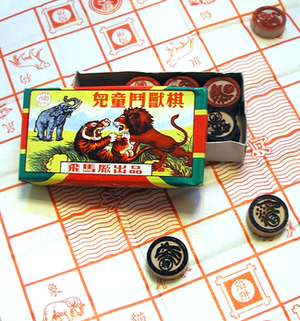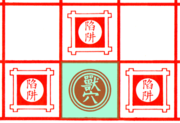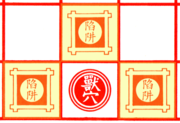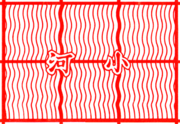- Jungle (board game)
-
Jungle or Dou Shou Qi (Chinese: 鬥獸棋, Game of Fighting Animals) is a traditional Chinese board game. It is also known as Jungle Chess or Animal Chess. It is a two player, abstract strategy game played on a 7x9 board. The game has been cited to resemble the western game Stratego [1] but Stratego actually has more in common with another Chinese board game known as Jun Qi (Chinese: 軍棋) or "Army Game".
Contents
Rules
Objective
The goal of the game is either to move a piece onto a special square, the den, on the opponent's side of the board, or capture all of the opponent's pieces.
Board
The Jungle game board consists of seven columns and nine rows of squares. Pieces move on the square spaces as in international chess, not on the lines as in xiangqi. Pictures of eight animals and their names appear on each side of the board to indicate initial placement of the game pieces. After initial setup, these animal spaces have no special meaning in gameplay.
There are several special squares and areas of the Jungle board: The Den (獸穴; pinyin: shòu xuè, "lair") is located in the center of the first row or rank of the board, and is labeled as such in Chinese. Traps (陷阱; pinyin: xiàn jǐng, "snare") are located to each side and in front of the Den, and are also labeled in Chinese. Two water areas or Rivers (河川; pinyin: hé chuān, "river") are located in the center of the Jungle board. Each comprises six squares in a 2x3 rectangle, and labeled with the Chinese characters for "river". There are single columns or files of ordinary land squares on the edges of the board, and down the middle between the rivers.
Pieces
Each side has 8 pieces representing different animals, each with a different rank. Higher ranking pieces can capture all pieces of identical or weaker ranking. However, there is one exception: The elephant may not capture the rat while the rat may capture the elephant. The animal ranking, from strongest to weakest, is:
- 8 - Elephant (Chinese: 象; pinyin: xiàng)
- 7 - Lion (simplified Chinese: 狮; traditional Chinese: 獅; pinyin: shī)
- 6 - Tiger (Chinese: 虎; pinyin: hǔ)
- 5 - Leopard (Chinese: 豹; pinyin: bào)
- 4 - Wolf (Chinese: 狼; pinyin: hǎng, láng)
- 3 - Dog (Chinese: 狗; pinyin: gǒu)
- 2 - Cat (Chinese: 貓; pinyin: māo)
- 1 - Rat (Chinese: 鼠; pinyin: shǔ)
Pieces are placed onto the corresponding pictures of the animals which are invariably shown on the Jungle board.
Movement
Players alternate moves with White moving first. During their turn, a player must move. Each piece moves one square horizontally or vertically (not diagonally). A piece may not move to its own den.
There are special rules related to the water squares:
- The Rat is the only animal that is allowed to go onto a water square. However, some players prefer Dog is also allowed to go onto a water square, which makes it easier to capture the opponent's Rat in the water.
- The Rat may not capture the Elephant or another Rat on land directly from a water square. Some players prefer Dog is also allowed to go onto a water square. In such case, the Dog may not capture the Rat on Land directly from a Water Square.
- The Rat may attack the opponent Rat in the water if both pieces are in the water. Some players prefer Dog is also allowed to go onto a water square, which makes it easier to capture the opponent's Rat in the water. The Dog may attack the opponent's Rat in the water if the Dog piece is in the water.
- A Rat on land may not attack a Rat in the water.
- The Lion and Tiger pieces may jump over a river by moving horizontally or vertically. They move from a square on one edge of the river to the next non-water square on the other side. Such a move is not allowed if there is a Rat(whether or not friendly or enemy) on any of the intervening water squares. Some players prefer Dog is also allowed to go onto a water square. The Dog(friendly or enemy) on any of the intervening Water Square may also prevent the Lion and the Tiger from jumping over the River. The Lion and Tiger are allowed to capture enemy pieces by such jumping moves.
Capturing
Animals capture the opponent pieces by "eating" them. A piece can capture any enemy piece which has the same or lower rank, with the following exceptions:
- The Rat may kill (capture) the Elephant. Many published versions of the game say this is done by the Rat crawling in the Elephant's ear and gnawing at his brains. As stated above, the Rat may not capture the Elephant from a water square. The powers of the Rat resemble those of the Spy in Stratego.
- The player may capture any enemy piece in one of the player's trap squares regardless of rank.
Variations
There are some commonly played variations to the rules official published by the board/pieces maker as follows:
- The Elephant may not kill the Rat under any circumstances. This is because a rat is able to dodge the attack of an elephant because of its size.
- Some play the game with the Lion and Tiger being equally strong, and they can kill each other. This is the more modern version.
- The Leopard may jump over the river horizontally but not vertically (due to its lesser strength than the Tiger or Lion). It cannot jump over a rat in the river though.
- All traps are universal. If an animal goes into a trap in its own region, an opponent animal is able to capture it regardless of rank difference if it is beside the trapped animal. The rules for being on one's own trap do vary.
- A variant has the Wolf replaced by the Fox, in which case the Dog is stronger than the Fox.
- There are variations in which the Lion is not able to jump across the river horizontally.
- The rules for the Rat to capture either the Elephant or Rat from or into the water do vary.
- There is a simplified version called Animal Checkers, which has no traps or rivers, and only the Rat, Dog, Tiger and Elephant.[2]
- Amongst the many examples shown on boardgamegeek there is at least one where the pieces are designed so that they are no longer visible by the opponent (mounted as a card on a stand like Stratego pieces). This apparently minor change alters the game from one of stochastic 'full-knowledge' to one of partial-knowledge.
- There is a version of the game that limits which animals (levels 1 - 4) can move on to the trap squares.
- Some players prefer the Dog may also move onto a Water Square. This is because dogs are good swimmers.
See also
Notes
- ^ Freeman, Jon. (1979). The Playboy Winner's Guide to Board Games. New York: Playboy Press. ISBN 0-87216-562-0. Retrieved January 29, 2007 from http://edcollins.com/stratego/stratego-freeman.htm
- ^ Animal Checkers. (2007). Retrieved May 20, 2007 from http://www.cse.unsw.edu.au/~cs3411/07s1/hw3/.
References
- Bell, R. C. (1979). The Boardgame Book. New York: The Viking Press. ISBN 0-89535-007-6.
External links
Categories:- Chinese games
- Abstract strategy games
- Traditional board games
Wikimedia Foundation. 2010.





